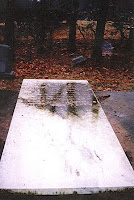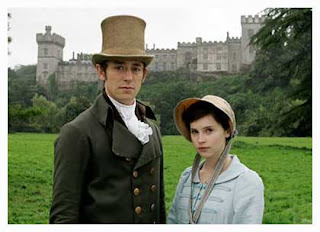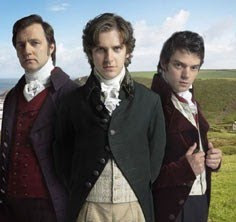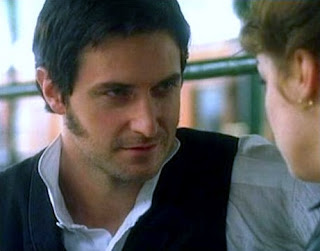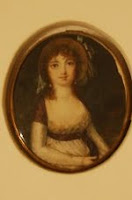 Happy Tuesday, everyone! Hope your holiday shopping is almost done, and your errands complete (I’m planning to take the dogs to have their Santa photo taken this week, but other than that I’m done. I think). My Undone story, The Maid’s Lover, is still on eHarlequin if you’re in the mood for a Christmas story, and I just found out I have a new title for my next Undone (out in March 2010!)–To Bed a Libertine. I think that about says it all.
Happy Tuesday, everyone! Hope your holiday shopping is almost done, and your errands complete (I’m planning to take the dogs to have their Santa photo taken this week, but other than that I’m done. I think). My Undone story, The Maid’s Lover, is still on eHarlequin if you’re in the mood for a Christmas story, and I just found out I have a new title for my next Undone (out in March 2010!)–To Bed a Libertine. I think that about says it all.
When I was trying to find a topic for today’s post, I came across the fact that Eliza Poe (actress and mother of Edgar Allen) died on December 8, 1811, and I remembered a book I found once at a library sale, The Brief Career of Eliza Poe (by Geddeth Smith, Fairleigh Dickinson University Press, 1988). I had to go and dig through my boxes in search of it, and found that aside from her famous (and famously weird!) son, Eliza had an interesting life of her own.
She was born Elizabeth Arnold in London in 1787. Her mother, also Elizabeth, was an actress in London until she married Henry Arnold and gave birth to her daughter. Henry died in 1789, and mother and child moved to Boston in search of a new life. Eliza made her debut at the age of 9, a character named Biddy Blair in a farce titled Miss In Her Teens by David Garrick, and received a good review in the Portland Herald, “Miss Arnold exceeded all praise. Although a miss of only nine years old, her powers as an actress will do credit to any of her sex of maturer age.” Later that year her mother married again, to a musician named Charles Tubbs, and they joined with a manager named Mr. Edgar to form their own troupe, the Charleston Comedians. Elizabeth senior died not long after this, probably as the company toured through North Carolina in 1798.
 Eliza junior stayed with the troupe, traveling with them from city to city. She was a hit at the Chestnut Street Theater in Philadelphia, a large theater seating over 2000. Over the course of her career, she played over 300 roles, including her best-known parts of Juliet and Ophelia.
Eliza junior stayed with the troupe, traveling with them from city to city. She was a hit at the Chestnut Street Theater in Philadelphia, a large theater seating over 2000. Over the course of her career, she played over 300 roles, including her best-known parts of Juliet and Ophelia.
In the summer of 1802 she married Charles Hopkins, who died of yellow fever 3 years later, leaving her an 18-year-old widow. Six months after this untimely loss, Baltimore-born David Poe saw her performing in Norfolk, Virginia and fell deeply in love with her on sight. He abandoned his family’s plans for him to study law and joined her troupe. They married in 1806, and traveled throughout New England, playing to acclaim in Philadelphia and an outdoor summer theater in New York City before settling in Boston, where they stayed for 3 straight seasons in a theater of about 1000 seats. Besides her acting skills, reviews noted her “sweetly melodious voice” and “interesting figure.” Times were financially difficult, but they had 2 sons, William (born in 1807) and Edgar in 1809. (Eliza performed up until about 10 days before giving birth to him, in a boarding house near Boston Common). They moved to New York in summer 1809, where Eliza was praised for her talent while her husband was subject to harsh criticism (possibly suffering from crippling stage fright). He took to drinking heavily and became more and more hot-tempered. His exact fate is not known, but he’s thought to have died around December 1811. Eliza had one more child, a daughter Rosalie, born in 1810 (Rosalie is thought to have been mentally impaired in some way).
In autumn 1811, while staying at a boarding house in Richmond, Virginia for performances, Eliza began coughing blood, and by October she ceased performing altogether. Her last appearance was October 11, 1811, as Countess Wintersen in The Stranger. Other actors took care of the children while she was ill, and many in the theatrical community of Richmond took an interest in the family. On November 29, the Richmond Theater held a benefit performance on her behalf, announcing, “On this night, Mrs. Poe, lingering on a bed of disease and surrounded by her children, asks your assistance and asks it for perhaps the last time.” (Got that? The last time! Plus this theater burned down 3 weeks after Eliza died)
She died of tuberculosis on December 8 at the age of 24, her children at her side, and was buried at St. John’s Episcopal Church there in Richmond. The exact spot is unknown, though there’s now a memorial marker to her there. After this her 3 children were split up, William living with his paternal grandparents in Baltimore, Rosalie adopted by William and Jane Mackenzie in Richmond, and Edagr staying in that city also with adoptive parents John and Frances Allen. It’s speculated that this early loss of his mother (and also his young cousin/wife years later) inspired Poe’s favorite theme of dying women in Gothic circumstances.
Along with the Smith book (which has some great details of Regency-era theater life), there’s info about Eliza Poe in Jeffrey Meyers’ Edgar Allen Poe: His Life and Legacy.
Do you have any favorite Poe stories? When I was a kid, I found a copy of his complete works on my parents’ shelves and scared myself silly with them. (Until my parents took it away so I would quit waking them up in the middle of the night because I was sure someone who was un-dead was knocking on my wall…)







